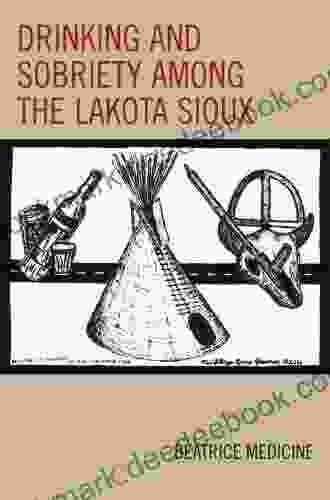Drinking and Sobriety Among the Lakota Sioux: A Contemporary Native American Perspective

Alcohol abuse and addiction have long been a problem among the Lakota Sioux, a contemporary Native American tribe. The rates of alcoholism and alcohol-related deaths are far higher among Lakota Sioux than among the general population. This article explores the complex relationship between drinking and sobriety among the Lakota Sioux, examining the historical, cultural, and social factors that have contributed to high rates of alcohol abuse and addiction within the community, as well as the efforts being made to promote sobriety and healing.
The history of alcohol abuse among the Lakota Sioux is closely tied to the history of colonization and oppression. When European settlers first arrived in North America, they introduced alcohol to Native American tribes. Alcohol was often used as a tool of conquest, as it was used to trade for land and resources and to weaken the resolve of Native American warriors.
Over time, alcohol became a part of Lakota Sioux culture. It was used at social gatherings, ceremonies, and religious rituals. However, alcohol also began to be used as a way to cope with the trauma and stress of colonization and oppression.
5 out of 5
| Language | : | English |
| File size | : | 1309 KB |
| Text-to-Speech | : | Enabled |
| Enhanced typesetting | : | Enabled |
| Word Wise | : | Enabled |
| Print length | : | 162 pages |
| Screen Reader | : | Supported |
In addition to historical factors, there are also cultural factors that contribute to high rates of alcohol abuse among the Lakota Sioux. For example, there is a strong tradition of drinking among the Lakota Sioux. Drinking is often seen as a way to socialize, celebrate, and cope with stress.
There is also a lack of access to mental health services in many Lakota Sioux communities. This means that people who are struggling with alcohol abuse or addiction may not have access to the help they need.
There are also a number of social factors that contribute to high rates of alcohol abuse among the Lakota Sioux. For example, there is a high rate of poverty and unemployment in Lakota Sioux communities. This can lead to stress and depression, which can in turn lead to alcohol abuse.
There is also a lack of affordable housing in many Lakota Sioux communities. This can lead to overcrowding and unsanitary living conditions, which can also contribute to alcohol abuse.
There are a number of efforts being made to promote sobriety and healing among the Lakota Sioux. These efforts include:
- Alcohol treatment programs: There are a number of alcohol treatment programs available to Lakota Sioux people. These programs provide counseling, support, and other services to help people overcome alcohol abuse and addiction.
- Sober living homes: Sober living homes provide a safe and supportive environment for people who are recovering from alcohol abuse. These homes offer a structured environment where people can focus on their recovery.
- Community support groups: There are a number of community support groups available to Lakota Sioux people who are struggling with alcohol abuse or addiction. These groups provide a safe and supportive environment where people can share their experiences and learn from each other.
- Cultural healing programs: Cultural healing programs incorporate traditional Lakota Sioux practices into the recovery process. These programs help people to connect with their culture and to find healing through traditional ceremonies and rituals.
Alcohol abuse and addiction are significant problems among the Lakota Sioux, a contemporary Native American tribe. However, there are a number of efforts being made to promote sobriety and healing within the community. These efforts are important in helping the Lakota Sioux to overcome the legacy of colonization and oppression and to build a healthier future.
5 out of 5
| Language | : | English |
| File size | : | 1309 KB |
| Text-to-Speech | : | Enabled |
| Enhanced typesetting | : | Enabled |
| Word Wise | : | Enabled |
| Print length | : | 162 pages |
| Screen Reader | : | Supported |
Do you want to contribute by writing guest posts on this blog?
Please contact us and send us a resume of previous articles that you have written.
 Book
Book Novel
Novel Page
Page Chapter
Chapter Story
Story Genre
Genre E-book
E-book Magazine
Magazine Newspaper
Newspaper Paragraph
Paragraph Bibliography
Bibliography Foreword
Foreword Preface
Preface Synopsis
Synopsis Annotation
Annotation Footnote
Footnote Manuscript
Manuscript Scroll
Scroll Tome
Tome Biography
Biography Autobiography
Autobiography Memoir
Memoir Thesaurus
Thesaurus Character
Character Resolution
Resolution Librarian
Librarian Catalog
Catalog Card Catalog
Card Catalog Study
Study Scholarly
Scholarly Reserve
Reserve Academic
Academic Journals
Journals Reading Room
Reading Room Rare Books
Rare Books Special Collections
Special Collections Interlibrary
Interlibrary Literacy
Literacy Awards
Awards Theory
Theory Catherine E Rymph
Catherine E Rymph Ben Clanton
Ben Clanton Lawrence Mcfadden
Lawrence Mcfadden James M Doran
James M Doran K N Chimbiri
K N Chimbiri Diana Palmer
Diana Palmer Anthony Rolls
Anthony Rolls Linda Tamura
Linda Tamura David L Lightner
David L Lightner Linda Metcalf
Linda Metcalf Mj Fields
Mj Fields Sylvia Ellis
Sylvia Ellis Harold Stiver
Harold Stiver Elizabeth Hardwick
Elizabeth Hardwick Philip Wallis
Philip Wallis Jorge Morel
Jorge Morel Luca Roncoroni
Luca Roncoroni Victoria Dickenson
Victoria Dickenson Anthea Hatfield
Anthea Hatfield Jeri Westerson
Jeri Westerson
Light bulbAdvertise smarter! Our strategic ad space ensures maximum exposure. Reserve your spot today!
 Galen PowellFollow ·5.6k
Galen PowellFollow ·5.6k Donald WardFollow ·18.4k
Donald WardFollow ·18.4k Grayson BellFollow ·17.6k
Grayson BellFollow ·17.6k Arthur Conan DoyleFollow ·4k
Arthur Conan DoyleFollow ·4k Marcus BellFollow ·16.7k
Marcus BellFollow ·16.7k Billy PetersonFollow ·13.1k
Billy PetersonFollow ·13.1k William WordsworthFollow ·14.4k
William WordsworthFollow ·14.4k Haruki MurakamiFollow ·14.7k
Haruki MurakamiFollow ·14.7k

 Oscar Wilde
Oscar WildeDon't Stop Thinking About the Music: Exploring the Power...
Music is an...

 Floyd Richardson
Floyd RichardsonSnowman Story Problems Math With Santa And Friends
It's a cold winter day, and...

 W. Somerset Maugham
W. Somerset MaughamWhat Every Classroom Teacher Needs To Know: A...
Teaching is a challenging...

 Edgar Cox
Edgar CoxTall Tales But True: A Lifetime of Motorcycling...
I've been riding motorcycles for over 50...

 Chinua Achebe
Chinua AchebeBuni: Happiness Is a State of Mind
Buni is a beautiful...

 Herman Melville
Herman MelvilleThe Arts and Crafts of Older Spain: Embodying the Essence...
In the heart of the Iberian...
5 out of 5
| Language | : | English |
| File size | : | 1309 KB |
| Text-to-Speech | : | Enabled |
| Enhanced typesetting | : | Enabled |
| Word Wise | : | Enabled |
| Print length | : | 162 pages |
| Screen Reader | : | Supported |












